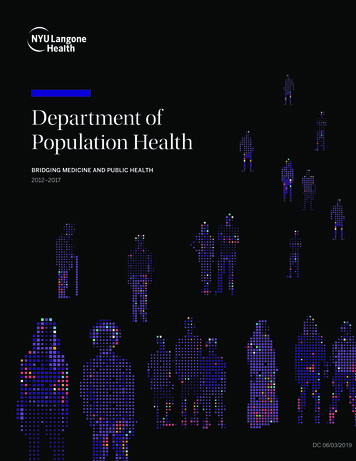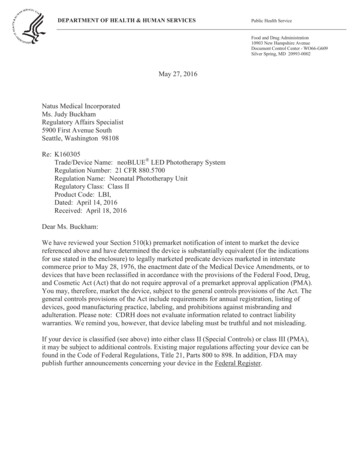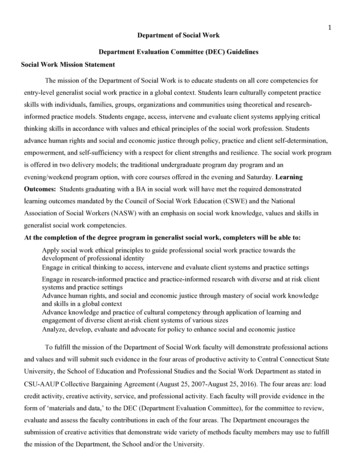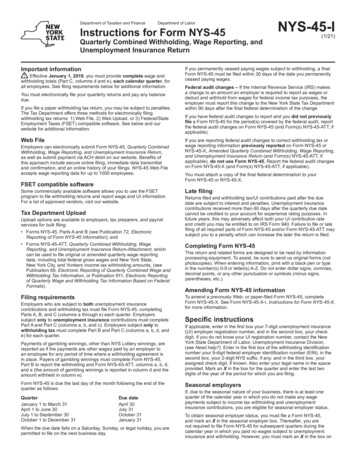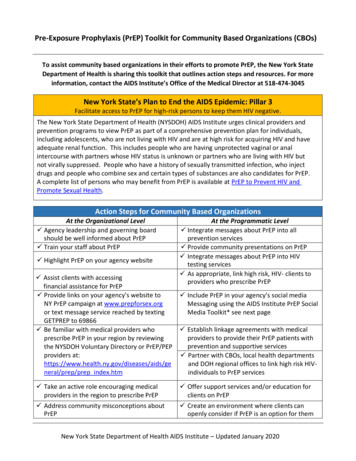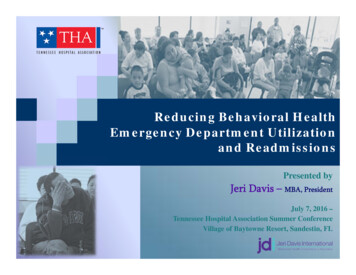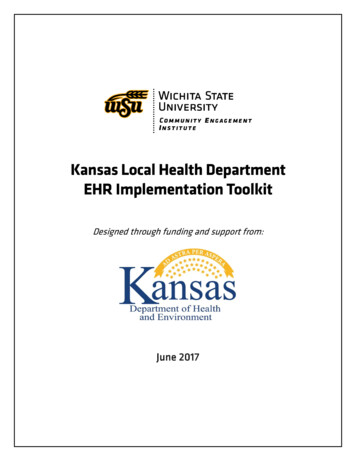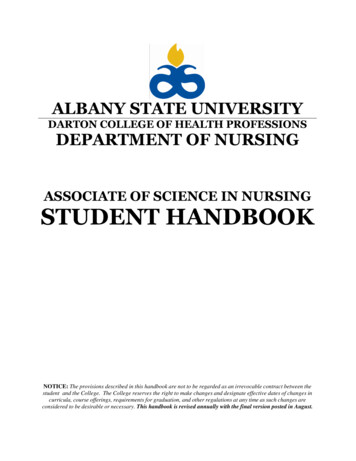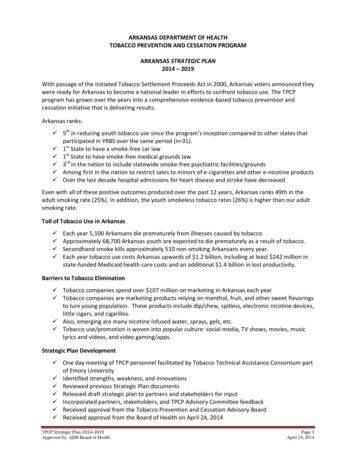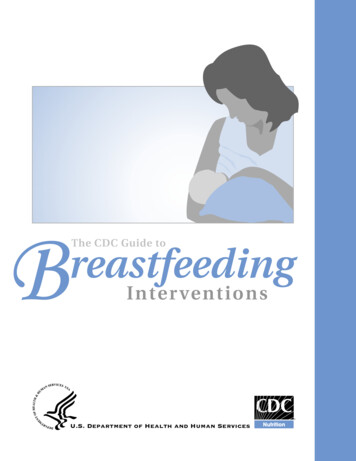
Transcription
U.S. Department of Health and Human Services
Katherine R. Shealy, MPH, IBCLC, RLCRuowei Li, MD, PhDSandra Benton-Davis, RD, LDLaurence M. Grummer-Strawn, PhDU.S. DEPARTMENT OF HEALTH AND HUMAN SERVICESCenters for Disease Control and PreventionNational Center for Chronic Disease Prevention and Health PromotionDivision of Nutrition and Physical Activity
AcknowledgmentsWe gratefully acknowledge and thank all contributors and reviewers of The CDC Guide toBreastfeeding Interventions. The efforts of Jane Heinig, PhD, IBCLC, RLC,Deborah Galuska, PhD, Diana Toomer, Barbara Latham, RD, LD,Carol MacGowan, MPH, RD, LD, Robin Hamre, MPH, RD, and membersof the CDC Obesity Team helped make this document possible.Publication Support was provided by Palladian Partners, Inc., under Contract No. 200-980-0415for the National Center for Chronic Disease Prevention and Health Promotion,Centers for Disease Control and Prevention, U.S. Department of Health and Human Services.Photographs contained in this guide were purchased solely for educational purposesand may not be reproduced for commercial use.Recommended CitationShealy KR, Li R, Benton-Davis S, Grummer-Strawn LM. The CDC Guide to BreastfeedingInterventions. Atlanta: U.S. Department of Health and Human Services,Centers for Disease Control and Prevention, 2005.For more information or to download this document or sections of this document, please visithttp://www.cdc.gov/breastfeedingTo request additional copies of this document, please email your request tobfguide@cdc.govor write to us at the following address and requestThe CDC Guide to Breastfeeding Interventions:Maternal and Child Nutrition Branch, Division of Nutrition and Physical ActivityNational Center for Chronic Disease Prevention and Health PromotionCenters for Disease Control and Prevention4770 Buford Highway, NEMailstop K–25Atlanta, Georgia 30341-3717
ContentsIntroductionIntroduction . . . . . . . . . . . . . . . . . . . . . . . . . . . . . . . . . . . . . . . . iUsing This Guide . . . . . . . . . . . . . . . . . . . . . . . . . . . . . . . . . . iiiEvidence-Based InterventionsMaternity Care Practices . . . . . . . . . . . . . . . . . . . . . . . . . . . . . . 1Support for Breastfeeding in the Workplace . . . . . . . . . . . . . . . 7Peer Support . . . . . . . . . . . . . . . . . . . . . . . . . . . . . . . . . . . . . . 13Educating Mothers . . . . . . . . . . . . . . . . . . . . . . . . . . . . . . . . . 19Professional Support . . . . . . . . . . . . . . . . . . . . . . . . . . . . . . . . 23Media and Social Marketing . . . . . . . . . . . . . . . . . . . . . . . . . . 29Interventions Whose Effectiveness Has NotBeen EstablishedCountermarketing and the WHO International Code . . . . . . .Professional Education . . . . . . . . . . . . . . . . . . . . . . . . . . . . . .Public Acceptance . . . . . . . . . . . . . . . . . . . . . . . . . . . . . . . . . .Hotlines and Other Information Resources . . . . . . . . . . . . . .35414549ReferencesList of References . . . . . . . . . . . . . . . . . . . . . . . . . . . . . . . . . . 55AppendicesExpert Panel . . . . . . . . . . . . . . . . . . . . . . . . . . . . . . . . . . . . . . 63Glossary. . . . . . . . . . . . . . . . . . . . . . . . . . . . . . . . . . . . . . . . . . 65
IntroductionIntroductionUsing This Guide
IntroductionProtection, promotion, and support of breastfeeding arecritical public health needs. Healthy People 2010 1 sets goalsfor increasing both breastfeeding initiation and durationand decreasing disparities in these rates across all populations in the United States. Increased breastfeeding is alsoa major program area of the Centers for Disease Control and Prevention’s (CDC)State-Based Nutrition and Physical Activity Program to Prevent Obesity andOther Chronic Diseases.Healthy People 2010Goal 16-19: Increase the proportion of mothers whobreastfeed their babies16-19aIn the early postpartum period to 75%16-19bAt 6 months to 50%16-19cAt 12 months to 25%Many types of interventions have been implemented in the United States andelsewhere to try to increase breastfeeding initiation, to increase exclusive breastfeeding, and to increase its duration. Choosing the most appropriate interventionfor a given setting and population can be challenging given the breadth of possibilities. In an effort to support and assist states in making informed decisions andallocating funds wisely, CDC, with input from external experts in both breastfeeding and public health interventions, compiled this guide.Included in this guide are all the types of breastfeeding interventions that havebeen reviewed by the Cochrane Collaboration and published through theCochrane Library, a comprehensive collection of up-to-date information onthe effects of health care interventions. In the 21st century, effective health carerelies not only on individual medical skills but also on the best information on theeffectiveness of interventions being accessible to practitioners, patients, and policymakers. This approach is sometimes known as “evidence-based medicine.” TheCochrane Library is designed to provide information and evidence to supporthealth care decisions and inform those receiving care.2Because formal evaluation of breastfeeding interventions is not yet widespread,this guide includes some interventions that have not been formally evaluated butIntroductioni
Although human milk banking fulfills uniquemedical needs and requires greater supportthroughout the United States, it is not discussedin this guide. Banking human milk is not includedbecause it is not an intervention to promote orsupport breastfeeding per se. The reader can obtainspecific guidance on establishing a milk bank fromthe Human Milk Banking Association of NorthAmerica (http://www.hmbana.org).have an established history or a strong rationale. Wediscuss all major types of interventions known to havebeen implemented or thought to promote and supportbreastfeeding.As readers decide what types of breastfeeding interventions to implement locally, they are encouraged throughout the planning process to incorporate an infrastructureto formally evaluate the intervention. Additionally,where possible, they are urged to broadly disseminatetheir findings, especially in peer-reviewed journals, tohelp grow the canon of evidence on breastfeeding interventions and inturn assist others in making evidence-based decisions on breastfeeding.Publishing evaluation data is especially important if an intervention ischosen whose effectiveness has not been formally established.In developing this guide, CDC received detailed input and critique fromestablished experts representing the spectrum of breastfeeding in theUnited States as well as from professionals working within state healthdepartments within the framework of the CDC State-Based Nutritionand Physical Activity Program to Prevent Obesity and Other ChronicDiseases. The invaluable input from these experts helped focus and refinethis guide and thus improve it tremendously.The chapters of this guide are divided into two categories that are based onevidence for effectiveness. In the first category, the evidence is significant;in the second, it is limited. Readers should note that some interventionshave not been shown to be effective standing alone but have been evaluated when included as components of effective multifaceted interventions.Interventions of this type are described as such within the “Evidence ofEffectiveness” section. CDC does not discourage interventions with limitedevidence of effectiveness but recommends that if they are used, an evaluation of their effectiveness be carried out before widely disseminating theintervention.This guide is most appropriately used as an introduction to the manyinterventions that have been developed to protect, promote, and supportbreastfeeding. As policy makers begin to focus on a particular intervention,they can consult “Program Examples,” “Resources,” and the “List ofReferences” to acquire more in-depth information and to contact otherswho have implemented the intervention.iiThe CDC Guide to Breastfeeding Interventions
Using This GuideThis document provides guidance and direction in selecting a breastfeeding intervention. It offersthe most relevant information on each type of intervention to help the reader make wise decisions.The following categories of information havebeen included:described earlier in the chapter, such as contactinformation, Web links, and books.DefinitionBriefly describes the intervention, includingits target audience and specific goals.Note: Web site addresses of nonfederal organizations are provided solely as a service to our readers. Provision of an address does not constitutean endorsement of this organization by CDCor the federal government, and none should beinferred. CDC is not responsible for the contentof the individual organization Web pages.RationaleExplains why a particular type of intervention is important to breastfeeding.Evidence of EffectivenessDraws on the major peer-reviewed literatureto summarize support for the intervention aswell as evidence of no effects or of a negativeeffect. Includes the relevant Cochrane review,if available.Description and CharacteristicsHighlights characteristics and componentsof the intervention needed to effectivelyimplement it.Program ExamplesSummarizes high-quality examples of theintervention and describes unique aspects.Examples are provided to show the readerconcrete models of various interventions.These examples were selected with expertinput from the authors as well as recommendations from the Expert Panel. This listis not exhaustive, and other programs withsimilar characteristics may exist.ResourcesGuides the reader to further informationabout programs and other items of interestPotential Action StepsPresents a short list of activities that might beundertaken to begin implementing a particularintervention. This list can serve as a springboard for locally tailored approaches and helpjump-start local thinking on how to proceedwith implementation. The reader should notethat many effective programs use multipleapproaches to address a central theme.In addition to the categories of information foreach type of intervention, two other tools areprovided to make using this guide easier.ReferencesProvides a sequential list of all informationsources cited.GlossaryServes as a handy reference containing thedefinitions of certain technical terms and thefull names of commonly used acronyms andinitialisms appearing throughout the guide.Abbreviated terms are in bold the first timethey appear, and technical terms are in bold thefirst time they appear in each chapter.Introductioniii
Support for Breastfeeding in the WorkplacePeer SupportEducating MothersProfessional SupportMedia and Social MarketingEvidence-Based InterventionsMaternity Care Practices
Maternity Care PracticesDefinitionMaternity care practices related to breastfeeding take place duringthe intrapartum hospital* stay, such as practices related to immediateprenatal care, care during labor and birthing, and postpartum care.Some maternity care practices of interest are developing a written policyon breastfeeding, providing all staff (e.g., nurses, physicians, radiologystaff, pharmacy staff, food service and housekeeping staff ) with education and training, encouraging early breastfeeding initiation, supportingcue-based feeding, restricting supplements and pacifiers for breastfedinfants, and providing for post-discharge follow-up. Other maternity carepractices differ in their effect on breastfeeding. Both the use of medicationsduring labor and cesarean birth have been shown to have a negative effecton breastfeeding; however, providing continuous support during labor andmaintaining skin-to-skin contact between mother and baby after birthhave been demonstrated to have a positive effect on breastfeeding.RationaleThe maternity care experience exerts unique influence on both breastfeeding initiation and later infant feeding behavior. In the United States, nearlyall infants are born in a hospital, and even though their stay is typically veryshort, events during this time have a lasting meaning. Correspondingly,the hospital stay is known to be a critical period for the establishment ofbreastfeeding.Many of the experiences of mothers and newborns in the hospital andthe practices in place there affect how likely breastfeeding is to be established. In most cases, however, these experiences reflect routine practices atthe facility level, and new mothers rarely request care different from thatoffered them by health professionals. Prenatal education on breastfeeding can affect a mother’s decision to even consider it as a feeding option.Medications and procedures administered to the mother during laboraffect the infant’s behavior at the time of birth, which in turn affects the* We use the term “hospital” to include hospitals, birthing clinics, and freestanding birth centers.Maternity Care Practices1
infant’s ability to suckle in an organized and effective manner at the breast. Infants who are put to thebreast within the first few hours after birth continuebreastfeeding longer than those whose first breastfeeding is delayed. Mothers who room-in with their infantswill have more opportunities to practice breastfeedingbecause of the infant’s proximity.Breastfeeding is an extremely time-sensitive relationship. Experiences with breastfeeding in the first hoursand days of life significantly influence an infant’s laterfeeding. Because of its inextricable relationship with thebirth experience, breastfeeding must be supported throughout the maternity hospital stay, not postponed until the infant goes home.Evidence of EffectivenessA Cochrane review 3 found that institutional changes in maternity carepractices effectively increased breastfeeding initiation and durationrates. These changes can be part of a comprehensive set of changes, suchas those implemented in pursuit of BFHI (Baby Friendly HospitalInitiative)4 designation (established by the World Health Organization[WHO]/UNICEF),5,6 or they can be individual interventions such asincreasing the rooming-in of mothers and babies7 or discontinuing policesthat are not evidence based (e.g., routine prelacteal feeds).5,8Birth facilities that have achieved BFHI designation typically experiencean increase in breastfeeding rates.6 In addition, DiGirolamo et al.9 founda relationship between the number of Baby Friendly steps (included in theTen Steps to Successful Breastfeeding10 of BFHI) in place at a birth facilityand a mother’s breastfeeding success. The authors found that mothersexperiencing none of the Ten Steps to Successful Breastfeeding required forBFHI designation (see text box) during their stay were eight times aslikely to stop breastfeeding before 6 weeks as those experiencing five steps.This finding emphasizes the value of implementing incremental changewithin the hospital setting.Educating hospital staff through a 3-day training program has been shownto enhance compliance with optimal maternity care practices and increaserates of breastfeeding.11 Use of pacifiers by newborns is associated withfewer feedings per day and a shorter duration of breastfeeding overall.122The CDC Guide to Breastfeeding Interventions
Supplemental feeds to breastfed newborns negatively impact overall infanthealth as well as breastfeeding outcomes.13Distributing samples of infant formula to new mothers during the hospital stay has been demonstrated by a Cochrane review to negatively affectbreastfeeding.14 There appears to be a disproportionate negative impactof distributing formula samples on mothers who are particularly vulnerable, which includes those who are primiparous (first-time mothers), lesseducated, nonwhite, or ill during the postpartum period.14The Ten Steps to Successful Breastfeeding are as follows:1. Have a written breastfeeding policy that is routinelycommunicated to all health care staff.2. Train all health care staff in skills necessary to implementthis policy.3. Inform all pregnant women about the benefits andmanagement of breastfeeding.4. Help mothers initiate breastfeeding within a half-hourof birth.5. Show mothers how to breastfeed and how to maintainlactation even if they should be separated from their infants.6. Give newborn infants no food or drink other than breastmilk, unless medically indicated.7. Practice rooming-in—allow mothers and infants to remaintogether—24 hours a day.8. Encourage breastfeeding on demand.9. Give no artificial teats or pacifiers (also called dummies orsoothers) to breastfeeding infants.10. Foster the establishment of breastfeeding support groups andrefer mothers to them on discharge from the hospitalor clinic.Maternity Care Practices3
Continuous support during labor using trained labor assistants such asdoulas has been shown to improve breastfeeding outcomes.15 Immediateskin-to-skin contact between mother and infant has been associated withlonger duration of breastfeeding.16 Conversely, birthing practices suchas delayed timing of first breastfeeding and the use of labor analgesics,17epidural anesthesia,18 and surgical (cesarean) birth19 have all been demonstrated to negatively impact breastfeeding.Description and CharacteristicsBaby Friendly Hospital InitiativeThe Ten Steps have been implemented in over 19,000 maternity carefacilities worldwide as part of the Baby Friendly Hospital Initiative (BFHI).The term “baby friendly” was selected in part because it could be appropriately translated into languages all over the world. Designation as a BFHIfacility requires the facility to demonstrate adherence to all Ten Steps tooutside evaluators. Each of the Ten Steps has detailed requirements. Forexample, step 6 requires facilities to purchase all infant formula for patientsat fair market value. Evaluation is completed through anon-site visit that includes interviews with multiple staff andpatients and chart reviews. Currently, fewer than 50 hospitalsand maternity care facilities in the United States carry BFHIdesignation.Many different types of facilities have achieved BFHI statusin the United States, including very small facilities servingprimarily low-risk, high-income, privately insured patientsas well as very large facilities serving mostly high-risk,low-income, publicly insured, or uninsured patients.Comprehensive hospitals (offering medicine, surgery, obstetrics, etc.),military facilities, and freestanding birth centers have all achieved BFHIstatus. Regardless of the type of facility, those achieving BFHI designationsee improved health outcomes for infants and mothers as well as greaterpatient and staff satisfaction.5Incremental ChangeIn addition to reforming maternity care practices throughout the facility,hospitals and other care centers can implement changes one at a time thatincrementally improve maternity care and breastfeeding outcomes. Manyfacilities have instituted incremental change either to prepare to pursueBFHI status or as an alternative to the comprehensive approach taken by4The CDC Guide to Breastfeeding Interventions
BFHI. As evidence exists for each of the Ten Steps individually as well asfor maternity care practices not included in Ten Steps, incremental changeis a valid and often more marketable option.Incremental change can take the form of adding new practices that support breastfeeding, providing comprehensive education and training tostaff about breastfeeding andlactation management, abolishing practices known tonegatively affect breastfeeding, or any combination ofthese strategies. Incrementalsteps need not be limited tothose in the Ten Steps, yetshould be evidence based.Program ExamplesBaby-Friendly USA is responsible for designating BFHI facilitieswithin the United States and works with external evaluators tocoordinate all BFHI activities.The Texas Hospital Association and the Texas Department of Healthhave jointly develo
Atlanta: U.S. Department of Health and Human Services, Centers for Disease Control and Prevention, 2005. . infants, and providing for post-discharge follow-up. Other maternity care practices differ in t
